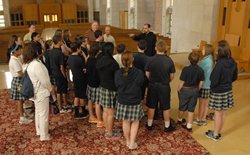
Father James Albers, OSB, prior of St. Benedict’s Abbey, Atchison, leads the vocations club of Holy Cross School in Overland Park on a tour of the abbey. By JD Benning.
by Joe Bollig
joe.bollig@theleaven.org
KANSAS CITY, Kan. — Ask any number of priests and religious, and a fair number will tell you the seeds of their vocation were sown not in their late teens or 20s, but as early as grade school.
Recognizing this reality, members of the Serra Club, pastors, schoolteachers and parishioners are cooperating to form vocations clubs for students in grades six through eight, and to establish parish vocations committees.
The first — and in some ways pilot — club was formed at Holy Cross School in Overland Park. The club, which became active during the 2011-2012 academic year, has 15 members.
The idea for the elementary school-level club came out of discussions held with former Holy Cross Parish pastor Father Bob Conroy.
“He asked last year, during the summer after he participated in two of our vocations committee meetings, ‘What can you do for the elementary school kids?’” said Bill McHale, director of the archdiocesan Serra Club’s College Connection Program.
So McHale and others developed a plan for a club, and incoming Holy Cross pastor Father Michael Stubbs approved and implemented it. It’s a parish program, but is supported by the school and the Serra Clubs.
The results have been positive, according to McHale. The club has already held a number of activities, including visits by seminarians and a field trip to St. Benedict’s Abbey in Atchison. Not only did all 15 club members go, but sufficient interest was generated that 10 student candidates who hope to join the club next year also went.
The entire program, however, is not adult-driven. Adult moderators worked with students to brainstorm appropriate activities.
They’ve discussed forming a “31 Club,” for example, which would pray for vocations for a set period of time, and have specifically invited youths to consider a vocation in a “Called by Name” program.
“Last year, we gave [archdiocesan vocations director] Father Mitchel Zimmerman 42 names to track for ‘Called by Name,’” said McHale. “Three years ago, we gave 24 names. The reason for this increase is that we went to elementary schools and asked the teacher, who knew the students, to identify kids who they thought might have a [religious] vocation.”
There are so far only a few other vocations-specific clubs in place in archdiocesan schools. McHale’s effort is directed mainly toward elementary schools, but at least one high school has two clubs, which were formed independently of McHale’s initiative.
Two were established at St. James Academy by Msgr. Ray Burger. They are the Magnificat Society for boys and the Fiat Society for girls, begun three and two years ago respectively. Sister Mary Bridget, FSGM, works with the girls; Msgr. Burger works with the boys.
“The main purpose of the [Magnificat] Society is to get together a group of young people interested in praying for religious vocations — not necessarily saying that they have a religious vocation, but they are interested in praying for vocations,” said Msgr. Burger.
The two societies have about 30 members each and meet once a month during the academic year. They also meet during the summer.
“In conjunction with the Magnificat Society at St. James, I work with the residents at the Santa Marta retirement center, and they also have a Magnificat Society,” said Msgr. Burger. “They pray for vocations and are given a specific name of a person at St. James to pray for, and the members at St. James pray for someone at Santa Marta. It’s a kind of exchange program of prayer.”
Something must be working. Two St. James graduates went into the seminary last year, and two more are on track to join them, said Msgr. Burger.
McHale is also trying to get parish vocations committees started in archdiocesan parishes. He has targeted 33 parishes and two colleges and, of those, seven have formed committees.
Separate, although related to these vocations efforts, is the College Connection Program of the Serra Clubs.
This program, which is nationwide and conducted by all American Serra Clubs, helps graduating Catholic high school students locate a Catholic campus ministry or nearby Catholic church when they go off to college.
The program in the archdiocese, said McHale, is growing. And as the number of participating parishes and schools rises, so, too, do the number of students into whose hands one of the prepared information packets is placed. Where there is a campus ministry available, incoming students’ names are also provided to the appropriate people at the campus centers.
“We got 350 names from the University of Kansas for the College Connection,” said McHale, “and gave them to the St. Lawrence Center [there].”
The benefits of the College Connection, according to McHale, can be seen in Catholic students who remain active in their faith, attend Mass more often, become leaders in their parishes after graduation, and are more likely to consider a religious vocation.






